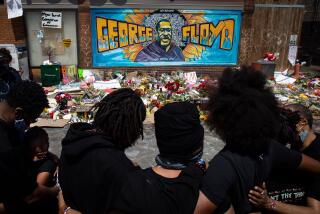TV Described as Being Catalyst for Lawlessness : Media: Coverage of the looting and violence informed potential participants that police were not responding and thus prompted more crimes, the panel concludes.
- Share via
Live television coverage of the initial outbreaks of violence in last spring’s Los Angeles riots was a catalyst for further looting and violence, according to the special panel investigating police response to the civil unrest.
In its report released Wednesday, the panel said television news coverage of the early flare-ups at Florence and Normandie avenues, and of a heated conflict at Parker Center between police and demonstrators, were crucial in informing potential rioters that police were not responding to the chaos.
“We are confident this was an unintended message, but the failure of police to act quickly and forcefully to uphold the law was shown graphically on television for all to see,” said the report in a section examining the initial police response.
“Television thus acted as a catalyst for the events to follow,” said the panel headed by former FBI and CIA Director William H. Webster.
The report also noted how television commentators “commented openly” on the lack of police combatting the unrest.
However, panel members stopped short of knocking the television coverage or the judgment of news executives, saving most of their criticism for former Police Chief Daryl F. Gates.
In addition, the report said the live coverage was probably less inflammatory than if news reports had just concentrated on minority rioters being handcuffed and arrested. “In this view, television pictures of an aggressive police response might have provoked further violence,” the report said.
Declining to take a position on the nature or amount of the news coverage, the report said that it was still the duty and obligation of police to respond quickly when it is clear that violence could escalate into civil disorder.
“Rapid and forceful responses in these two instances would significantly have altered the public perceptions of the developing environment in the city, and this was an important first step toward controlling the outburst of violence,” the report stated.
Most local television news directors either refused to comment on the report or could not be reached. But one news director continued to defend his station’s coverage, denying that the live reports helped fuel the violence.
“We told the community and the world what was happening,” said KTLA Channel 5 News Director Warren Cereghino. “We were not saying to our audience, ‘Hey, look what’s happening, come down here.’ The people who wanted to participate in the lawlessness saw a situation to exploit, and that’s because they’re lawless--not because they saw it on television.”
Cereghino added that there is also “a sizable part of the community that thanked us for letting them know what areas to avoid, and whether the rioting was getting close to their areas.”
He said that he would not have entertained the alternative of staying with regular programming and not showing the outbreaks.
“We never would have shrunk from showing what was happening,” he said. “And one of the basic rules of journalism is showing where a story is taking place.”
Jeff Wald, news director at KCOP Channel 13, agreed.
“We’re not in the censorship business,” Wald said. “We have to broadcast what is taking place and what is happening--that’s our credibility and link to the community.”
Channel 13 presented some of the most dramatic helicopter shots of truck driver Reginald O. Denny being beaten by rioters at Florence and Normandie.
Without naming any stations, Wald criticized coverage by some of his competitors, saying that they “milked” the story after the verdict.
He said Channel 13 broadcast the verdict and reaction from the Simi Valley courthouse, then went back to regular programming with a plan to come back in a later newscast and put the events into perspective.
“Once the verdicts were read and we got the reaction, I thought that was enough,” he said. “But I watched what the other stations were doing, and at times I thought there was too much overkill, that there was too much talk about it. Of course, those other stations had earlier newscasts to fill.”
Vern Bengtson, a professor of sociology at USC, said television was definitely a catalyst for the rioting.
“There was an immediate spreading of information that caused people to react in ways that they normally would not have reacted,” Bengtson said. “It allowed the barriers to come down between nonviolence and violent, antisocial behavior.”
Bengtson, however, added that “the news media have an obligation to be on the scene,” and that “people would have rioted whether there was TV coverage or not.”
More to Read
The complete guide to home viewing
Get Screen Gab for everything about the TV shows and streaming movies everyone’s talking about.
You may occasionally receive promotional content from the Los Angeles Times.







